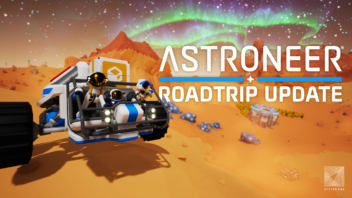Hello readers, I’m Paul Pepera, one of the artists working on Astroneer. “The Art of Astroneer” will be a multi-part series that will discuss the visual design of Astroneer. We hope to cover a wide variety of topics – from influences and inspiration to technical details and challenges that arose while creating the game.
For Astroneer we wanted an art style that was both visually striking and fast to execute. For a small team it was important for us to make decisions that we felt were realistically possible to achieve – one of those considerations was reducing content overhead. To that end we decided against an art direction that we were used to working in with our full time “AAA” jobs in favor of something much more minimalistic. We felt low-poly art direction was a good choice because it offers us the ability to execute content relatively inexpensively while still achieving a visual style that makes a strong statement.
“Low-poly” is a term used by game industry artists to describe an aesthetic which uses very minimal technical specs and is usually categorized as having bold geometric shapes and vibrant color palettes. Despite the aggressively low specs, low poly game art is still a very popular style that can be found practiced in all sorts of online art communities – such as Polycount and r/low_poly. It is an art style that harkens back to the 1990s before normal maps were a thing and specular highlights were painted into the texture maps.
The decision to choose such an art style was more than just aesthetic taste – it had far larger implications for the project. We are a very small team – with just 2 fulltime artists on the project. Setting a simplistic yet visually striking art style was a key production consideration as it means our content overhead is generally much lower than that of projects that have more realistic and detailed art directions. With the latest graphical fidelity requirements of current AAA games an artist can easily spend days and weeks on a single art asset. The technical demands of high-resolution mesh baking and complex shaders have made art asset production a massive time and budget sink.
Even this early on we knew we wanted a triangular, polygonal look to the terrain in particular. Something that requires no textures to achieve – which it still does not to this day. To contrast the the ‘natural’ terrain the man-made modules, while still very low-poly, had less of a faceted look to them. While the game’s look has evolved over the last couple of years at its core the decision to go with a low-poly look has remained intact.
Another way having such an art style helps is that it greatly opens up the audience of modders. As art fidelity continues to increase in AAA gaming the modding scene is impacted by the extra needs of developing for such art styles. With such development an art team today can be just as large as an entire mod team was 10 years ago. The art style of Astroneer greatly reduces the barrier to entry across a wide level of skillsets in the mod making community.
In the next installment of “The Art of Astroneer” we’ll talk about influences and sources of inspiration we draw from when designing and making the content for the game.
Astroneer will be available on Steam Early Access this year for Windows and Mac OS.
You can follow Astroneer on Twitter and Facebook, where we are actively sharing news and media content about the game.
If you’d like to find out when we’re ready for private testing or when a streamable build will be ready, sign up for the newsletter on the official website.
-Paul







More Astroneer Content in These Places